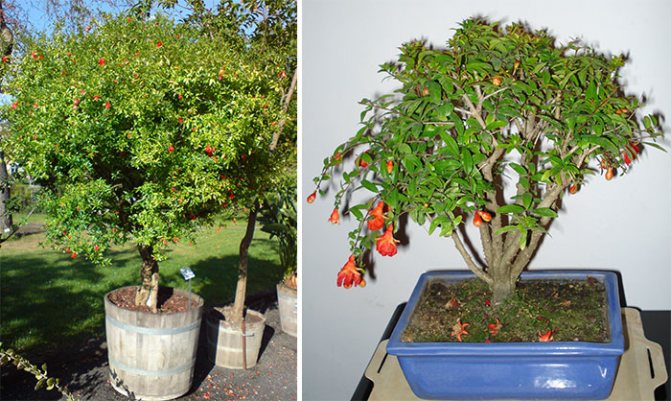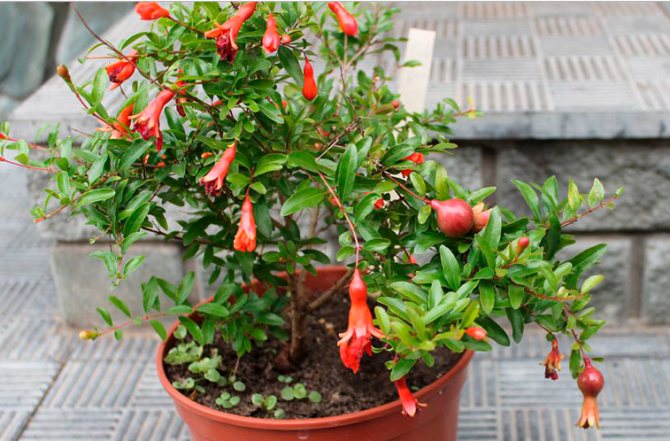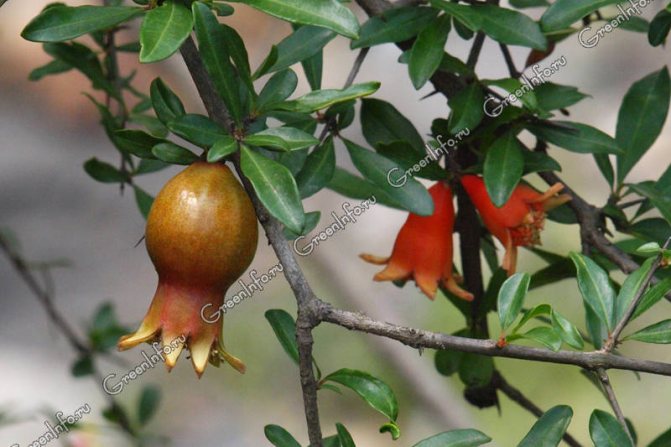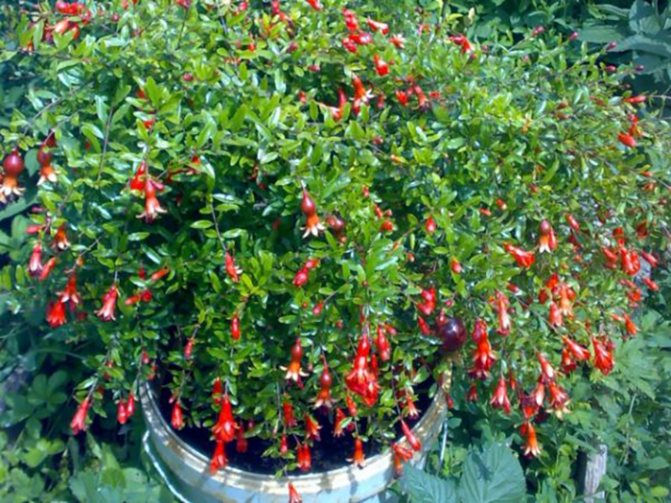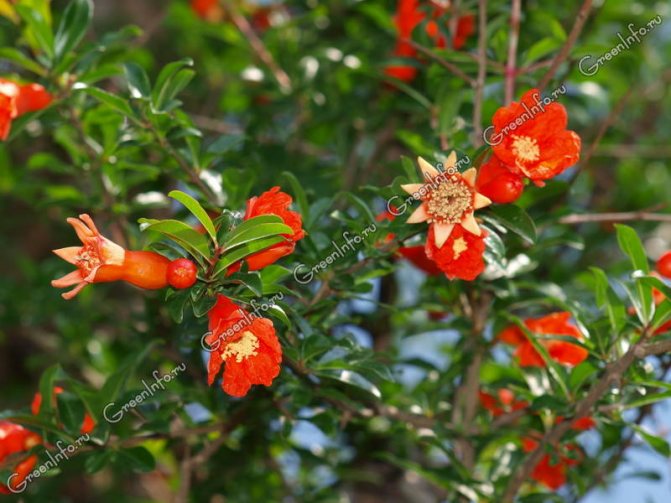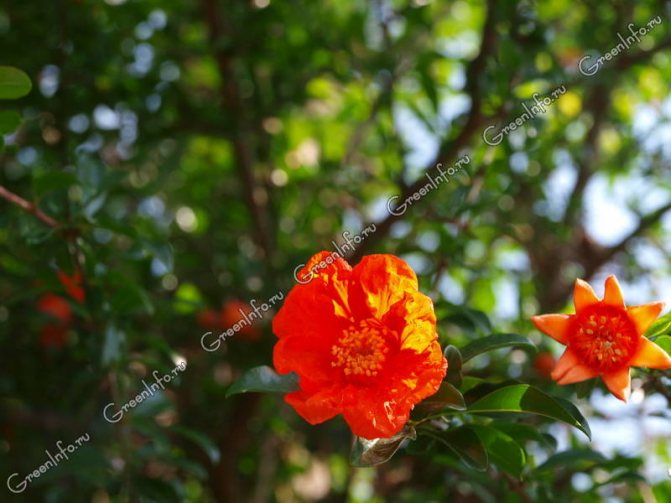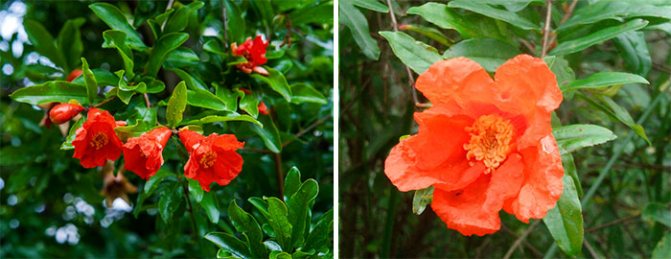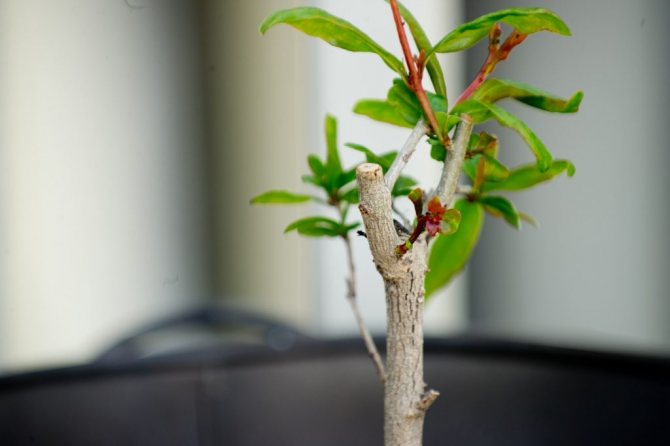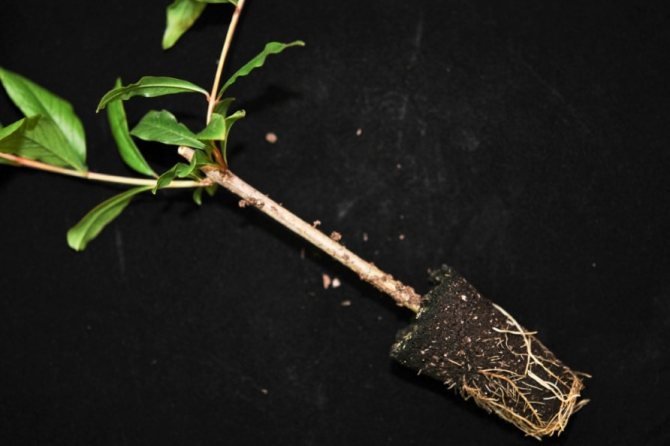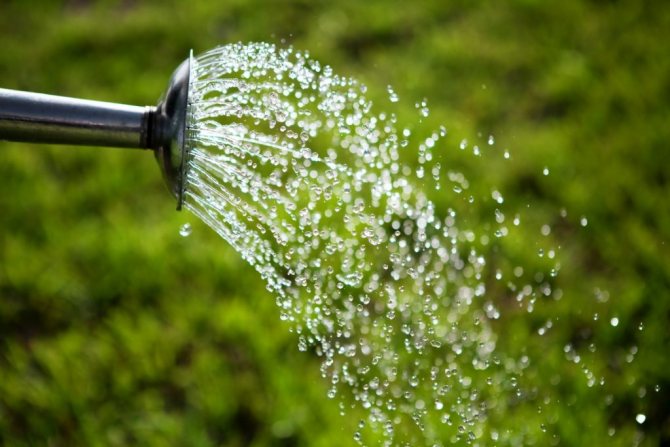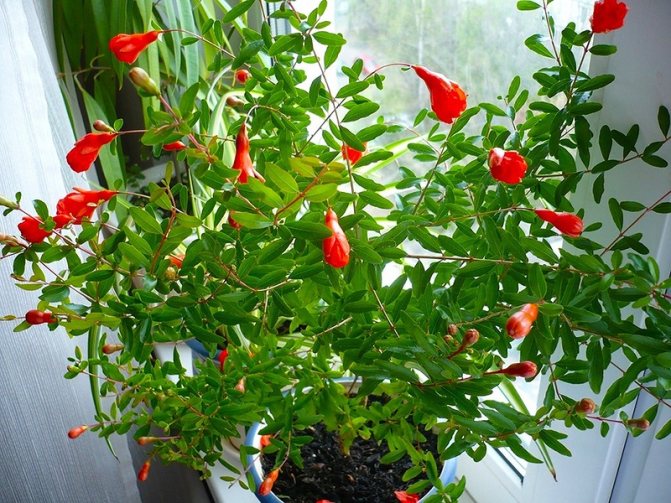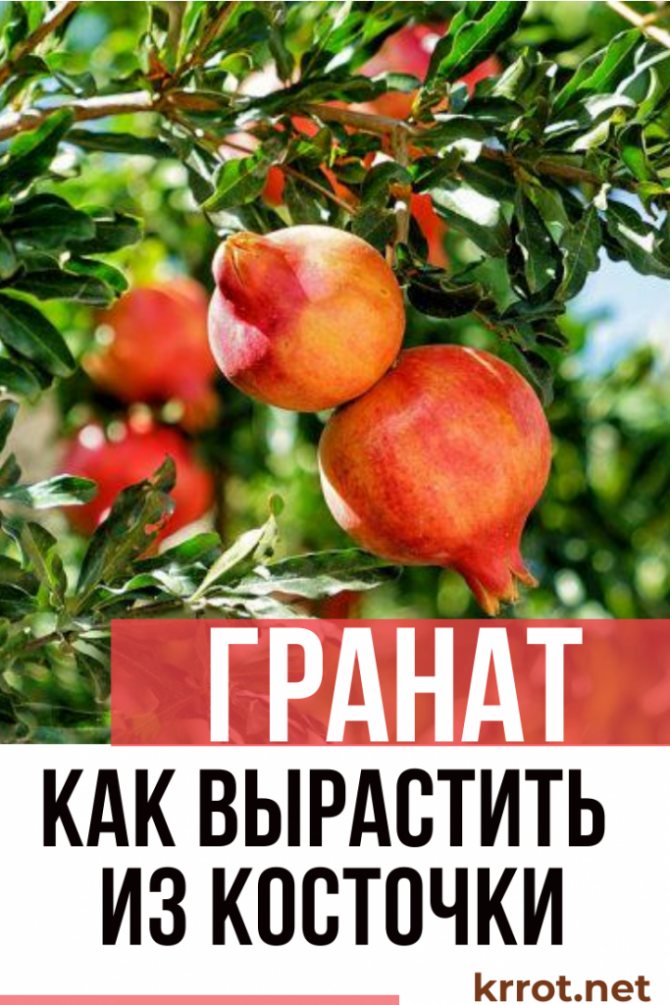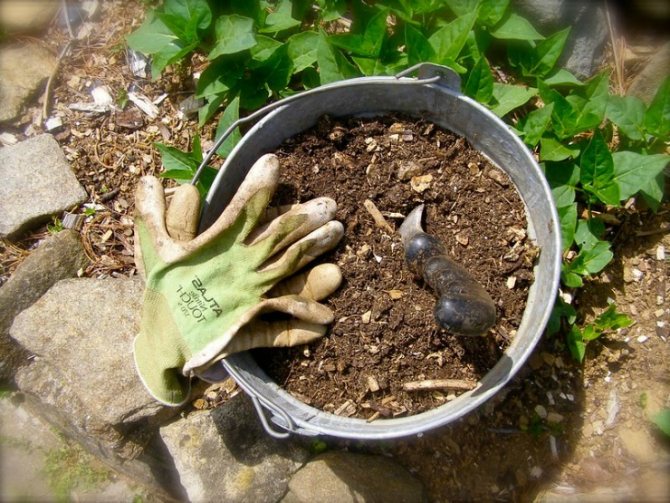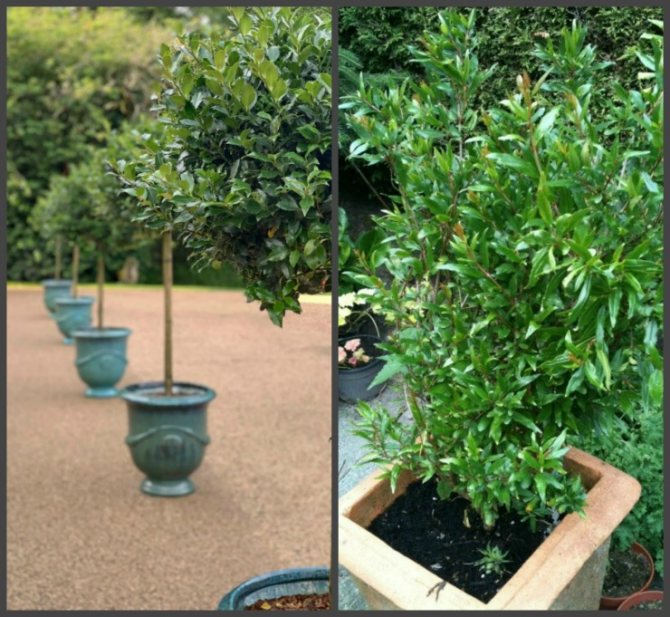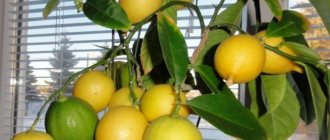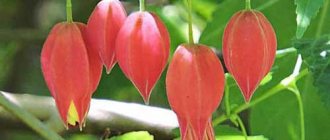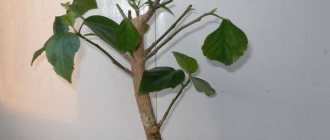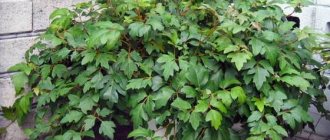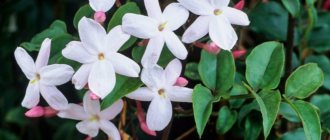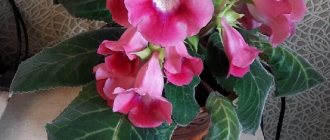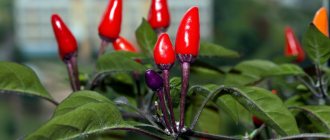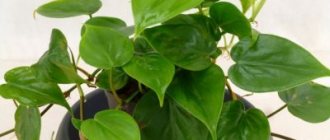Types, varieties of pomegranate and their photos
The Derbennikov family includes only two types of deciduous trees and small shrubs.
Common pomegranate (Punica granatum) is most suitable for growing at home. Naturally, the pomegranate tree grows in Southern Europe and Western Asia. It is a small tree up to 5-10 m in height, with green foliage and scarlet flowers. Ball-shaped fruits reach 8 to 18 cm in diameter.
Breeders have bred a large number of different garden forms and varieties, which differ in the taste of the fruit and the degree of their abundance.
Photo. Indoor pomegranate
Another form of Common Pomegranate, which is a natural species, is widespread in indoor floriculture - this is the Dwarf Pomegranate (Punica nana). It is small in size, no more than a meter, subject to regular pruning, it can be up to 30 cm high. It has small leaves and can bear fruit.
Some varieties of the original species, suitable for growing at home, but exceeding the size of the dwarf species, are less common among florists:
- "Flore Pleno" - the plant comes from Persia, has an exclusively decorative function, does not bear fruit. The size of the shrub reaches a height of 3-4 m. Terry bright red flowers resemble a carnation in shape;
- "Flore Pleno Alba" - similar to the previous species, but its flowers are white;
- "Double Flower" is another type of terry pomegranate with multi-colored flowers, where in one inflorescence there are simultaneously petals of red, white, pink flowers, they can be monochromatic, have stripes or specks.
In the natural environment, another - the second - plant species is known, this is the Socotran Pomegranate (Punica protopunica). His homeland is the island of Socotra. It is a tree or shrub with abundant branching. It can reach a height of 4.5 meters. It differs in smaller flowers, they are not red, but pink in color, smaller fruits and rounded leaves. This species was not accepted by gardeners due to its inferior taste.
Care
Caring for a indoor pomegranate at home is not as difficult as it might seem. Knowing the secrets of the success of experienced florists will help you understand the main parameters of the content:
- temperature - during growth, flowering and fruiting in the range from +18 to + 25 ° С, during winter dormancy from +12 to + 15 ° С, but not lower than + 6 ° С;
- lighting - the brightest place with shading from direct midday rays in summer, in winter they artificially extend daylight hours to 10 hours;
- watering - abundant and frequent in summer, significantly limited in winter;
- humidity - in the heat it needs to moisten the leaves or air around the bush;
- reproduction - by seeds, grafting or cuttings.
Growing pomegranate at home using cuttings
To grow pomegranate room care at home, for which, it will be easiest to carry out, you can propagate it with ordinary cuttings. It is this method that is considered the most common due to the complete preservation of genetic material and a high level of survival. As a result, the quality of the crop and the resistance of the seedling to diseases will depend on this.
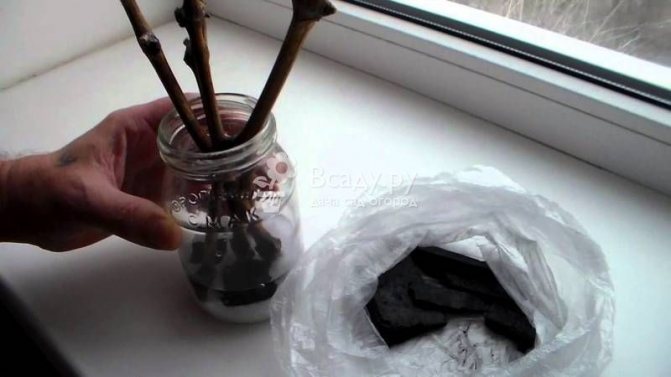
Rooting lignified pomegranate cuttings
- For layering at the very beginning of spring, the middle (about 15 cm) of an adult stem with 3-4 buds is selected.
- Then you can place the cutting in water or process it to stimulate growth with Kornevin.
- Rooting soil does not differ from that recommended for seed germination.
If all the stages are carried out properly, then in a month the pomegranate will have a primary root system, and new branches will begin to appear from the buds. Strengthened pomegranate trees are usually planted in separate pots after 1-2 months.
Reproduction and cultivation of indoor pomegranate does not differ from planting other ornamental plants. Sowing material can be seeds or cuttings. If the goal is to grow an ornamental plant for the sake of beauty, and not fruit, then you can use the seeds of an ordinary ripe pomegranate. To get delicious fruit, you should think about how and how to plant a houseplant.
From the cutting
When planting a cutting, all the characteristics of the variety are preserved. The plant blooms earlier and begins to bear fruit. Cuttings are harvested in early July or late winter. In the first case, the cuttings take root better. But the latter are more often used. The mother plant is less at risk of damage.
Cuttings are taken about 10 centimeters long with five or seven buds. The cut is made with a sharp knife at an angle, from fruit-bearing trees. Sections are treated with a root stimulant, planted in fertile soil at an angle. Cover with foil, keep warm, watered regularly.
After a month, the cuttings will take root, young buds will appear. The film is removed. For better branching, a third of the shoot is cut off.
From sunflower seeds
Store seeds can be used. Better to take the seeds of a ripe indoor pomegranate. They are cleaned of pulp, hard bones are selected. Before sowing, soak in water with a growth stimulator. Seeds should be sown in November or March, in a moistened mixture of peat and sand. Seedlings will appear in 2 weeks.


Seed material can be purchased at a florist shop. Several popular types of decorative pomegranate have the common name Punica granatum "nana" (or dwarf), the size varies from 30 to 100 cm. Nana-pomegranate requires fairly simple home care. Popular varieties:
- "Carthage dwarf" pomegranate can grow up to a meter;
- baby pomegranate is very miniature - 30-50 cm.
There are other, less popular indoor varieties, but they are larger and are not considered dwarf.
Propagation by seeds (seeds) from purchased fruits is not recommended, since these fruits are often hybrid, which means they do not carry the genes of the mother plant. But you can use the fruits ripened on indoor bushes. The ripest and largest are selected. Pits suitable for sowing must be firm and creamy.
Soft and greenish will not germinate. The pulp should be peeled off (otherwise it will rot during germination), the seeds should be washed, they can be kept in a weak solution of potassium permanganate and dried. Now they can be stored for up to six months. Fruits suitable for harvesting seeds ripen for winter. But the best time for any crops is spring, and the pomegranate will sprout quickly enough. At other times of the year, the process can take several months.
How to grow a tree from a seed? In March or April, they are sown in a container with loose soil under a film. Before planting pomegranates, it is better to soak the seeds in a growth stimulant solution for 12 hours. To do this, they are wrapped in damp gauze and covered with a film so that not only moisture but also air can be accessed.
You can simply put the bones in a saucer and pour in the liquid so that they are partially in the air. Such measures will speed up seedling. Growing a pomegranate indoor plant is made from fresh seeds, because they quickly lose their germination. They are deepened by 1 cm. They germinate within 2 weeks.For germination, you need light, heat 25-27 degrees, moist soil (you can save it from drying out by periodic spraying so as not to accidentally wash out the soil).
Vaccination
The method is a little time consuming, but effective. As a stock, you can take any young pomegranate tree, for example, obtained from a stone. But cuttings are used varietal, from a good, healthy, flowering and fruiting tree. The grafting method can be used by any of the known methods, for example in splitting or side-notching. The guarantee of survival is not absolute, but the chances are great.
Read next: Muscular horse color description and characteristics of the dressing appearance and origin
Cuttings
This method of reproduction is optimal, since the cuttings of the plant easily take root and take root, and all the genetic properties of the variety are preserved. For this, branches with 4-5 living buds are cut from the bush. The cuttings should be young, but already start to grow stiff. In spring and summer, rooting of small plants is faster.
Cut twigs are soaked in root growth promoters. The lower part is cleared of buds and stuck into the soil, slightly at an angle, 3-4 cm deep. Rooting is not a quick process, some of the cuttings will dry out, so it is better to plant several of them at once. As soon as the plants take root, new shoots will start up, you can plant each pomegranate in a separate pot.
Indoor pomegranate can be propagated in two ways.
Pomegranate propagation is carried out in two ways: by seeds and cuttings.
To get a pomegranate from seeds, you need to take ready-made ones, bought in a specialized store. In this case, flowering will begin in the year of planting, and fruiting in a year or two.
The seeds of a fresh fruit growing dwarf pomegranate are also suitable. Their germination capacity lasts up to six months. The seeds of the largest and most ripe fruits will do. They are washed from the pulp and dried. You can sow them in April, putting them in the ground no deeper than half a centimeter. Seed growth occurs quickly enough and then the strongest of the seedlings are planted in pots. Provides warmth and good watering when grown. You can pinch it several times.
Cuttings can also be taken from fruiting plants. In the summer, take semi-lignified shoots, and in February - lignified ones. They are cut, leaving 4-6 buds on each and planted in moistened soil at an angle. Each stalk is covered with a bottle or jar and left in a humid environment. Requires daily airing, spraying and watering. Cuttings are planted after 2-3 months. Bloom will come in a year or two.
Reproduction of the pomegranate tree
Pomegranate is propagated by:
- seeds;
- bones;
- cuttings;
- vaccination.
Propagation using seeds
When propagating by seeds, it must be borne in mind that only pomegranate species are suitable for taking planting material. The varieties do not retain the characteristics of the mother bush. The seeds are harvested from a flowering tree or bought in stores.
Landing is done like this:
- The seeds are soaked for 24 hours in Kornevin.
- The planting material is dried and sown in a container with loose, breathable soil.
- The seedlings are covered with plastic or glass, the container is placed in the greenhouse in a bright place. Seeds are ventilated daily.
- When the soil dries up, it is sprayed with warm, settled water. The first shoots appear after two to three weeks.
- Shoots dive into individual pots when three leaves appear on them.
Bushes grown from seeds bloom and yield only after five to eight years.


Propagation by seeds of indoor pomegranate
Reproduction using seeds
The seeds for growing are taken from large, ripe fruits. It is not difficult to select them: they are creamy, solid. Green and soft bones are not suitable for breeding.Planting is recommended in April:
- The pulp is removed from the seeds, they are washed in cool water (possibly with potassium permanganate), and dried thoroughly. Thanks to this treatment, it is possible to avoid decay, the planting material remains viable for up to six months.
- Before planting, the bones are soaked for half a day in a solution with two to three drops of Zircon or Epin. They do not have to be completely in water, they need oxygen.
- They are planted in a substrate to a depth of 0.5-1 centimeter in a pot with drainage.
- The container is placed in a warm place with good lighting. As the surface layer dries, the earth is moistened with warm soft water.
- When two or three leaves appear on the seedlings, they are moved into permanent pots with a circumference of up to six centimeters.
- Shoots from ten centimeters, having three pairs of leaves, pinch to improve branching.
With this method of cultivation, flowering is observed only after 6-9 years. In addition, the bush turns out to be large, it may not fit into the size of the apartment.
Propagation by cuttings
This method is most suitable for indoor cultivation due to the high percentage of germination and the retention of varietal characteristics of the parent plant. When planting in the summer, you need to take ripe semi-lignified shoots 10-15 cm long, with four to five buds. In winter, the same planting material is selected, but the percentage of germination decreases, it takes more time for rooting. Landing is done like this:
- Cuttings are treated with Kornevin.
- Two lower buds are removed from the planting material.
- The shoots are placed in a loose nutrient substrate at an angle, 3 cm deep. Cover with foil or glass. Ventilate daily, spray, water as needed.
- Rooting occurs in two to three months. It must be borne in mind that some of the shoots die. After complete rooting, the bushes can be repotted.
Flowering will begin next year. The pomegranate will bear fruit in two seasons.
Graft
A varietal cutting is grafted onto the stock. It is taken from a healthy fruiting bush. Vaccination can be done in different ways. If the scion takes root, flowering will begin in three to four years.
Plant lighting
Despite the fact that the pomegranate is not particularly picky about the conditions of detention, nevertheless, there are a number of rules that should not be violated.
The main requirement for proper plant maintenance is a high level of illumination. In order for flowering and fruiting to be abundant, it is best to provide the plant with direct exposure to sunlight. It feels great in the fresh air, so it can be transplanted into the garden.
In indoor conditions, it is best to place the pot on a south, west or east well-lit window. North windows should be avoided. On gloomy and cloudy days, turn on an additional phyto-backlight.
Indoor grenade requires a high level of lighting
You can shade the young seedlings of the plant a little at noon when the sun is too bright. In the summer, you can put the flower on the balcony, where it will have enough light and air.
In the winter season, with a lack of illumination, pomegranates can begin to partially shed their foliage. He can be helped if you put powerful phytolamps, providing a day of light for at least 12 hours. Under this condition, the flowering and fruiting of the plant will continue in winter.
Despite the fact that in the historical homeland of the pomegranate, the air temperature is usually quite high, for indoor species, a moderate summer heating of the air within 20-25 degrees is quite suitable. The plant does not like hot or stuffy air and can lose leaves. At the same time, growth slows down noticeably. In this case, cool sprays or moving the pot to cooler conditions, such as a balcony, will help.
Often there is an opinion among florists about the presence of a pronounced dormant period in a flower, which lasts from November to March.On this basis, you can find recommendations to place the pomegranate at this time of the year in a cooler place.
However, based on practical experience, it should be noted that if the flower is left in the winter at normal room temperature, there is no decrease in flowering intensity. Also, the content in the heat will not have a negative impact and will not affect the formation of flower buds in any way.
Not many people know how to care for a pomegranate in a pot. Home-style pomegranate is a plant that simply adores light and direct sunlight. Windows are perfect for the place of residence of the plant, but not from the north side.
In the middle of the day, it is best to close the tree from direct sunlight, especially if these are young seedlings that are not even several months old. It is necessary to hide the plant so that the leaves do not dry out.
In the warm summer period, it is best to take the trees to the balcony, where it will have enough light and oxygen. The plant must be gradually accustomed to the climate of the street and protected from direct rays during the day. In the fall, take it to the room, but do not keep it close to the radiator.
Such a plant requires a warm climate, especially in the period from autumn to spring, since at this moment the period of full flowering of the plant falls. Experts say that the best temperature for flowering is 20 ° C.


Experts say: the best temperature for flowering indoor pomegranate is 20 ° C
In a room where it is too hot or stuffy, the plant will begin to lose its leaves. This will slow down the development of the flower. To lower the temperature, you need to spray the plant with cold water from a spray bottle.
In order for the fruits to ripen precisely in the autumn, it is necessary to reduce the temperature in the room to 14 ° C. From November to March, the flower is best kept at a temperature of 12 ° C. This will provide the necessary climate for fruiting. The lowest temperature a flower can withstand is 6 ° C.
Resting state
It is sometimes quite difficult to create optimal conditions for the rest time in an apartment. In order not to harm the plant, it is enough to press it against the glass and fence it off with any film. This way the temperature can be maintained. It is necessary to keep the plant in this state for 3-4 weeks. If you have a basement, you can lower the plant there.
Diseases and pests
The Nana dwarf pomegranate is susceptible to disease and pests just like other houseplants. Preventive procedures and timely treatment will prolong the life of the plant.
Diseases
One of the most common diseases of Nana pomegranate is powdery mildew. The reasons for the appearance are sudden temperature changes in the room, poor ventilation or humid air. For treatment, they are treated with a solution of soda ash and soap (5 g per 1 liter). For large areas of damage - with a fungicide (Topaz, Skor).
If dwarf pomegranate roots turn yellow, reduce watering. Excessive moisture causes roots to rot. You need to remove them manually by cutting out the damaged area, and rinse the rest in potassium permanganate. Sprinkle the slices with activated carbon. Change the soil to a new mixture.
If the bark on the branches is cracked, and spongy swellings are visible in the depressions of the cracks, this is branch cancer. The disease covers the plant and it dies. The occurrence of branch cancer is facilitated by hypothermia of the pomegranate.
Pests


In indoor conditions, the Nana dwarf grenade is threatened by such pests: spider mites, scale insects or whiteflies. The shield is collected by hand. Whitefly eggs are washed off in the shower, and the plant is treated with Derris. The mite spider web is removed from the leaves with a swab dipped in garlic tincture. In case of severe damage, pomegranates are treated with special insecticides - Fitoverm, Aktara or Aktellik.
Attention! Before treatment with poisons, the soil is covered with polyethylene.
Necessary watering and air humidity
Proper watering is an important part of pomegranate care. If you adhere to the rules listed below, you can count on a good result.
- If it is winter outside, then it is best to leave the plant alone, it is better to water it once every two months.
- In February, it is necessary to gradually raise the watering of the plant. Flower - twice as often, so that the entire pot is well filled with water. To know exactly when to water, look at the top layer of the earth, when it's dry, then water.
- At the time of flowering, it is best to significantly reduce watering, since in nature during this period there is heat and dryness. But if the root system does not have enough moisture, or, on the contrary, there is too much of it, then the pomegranate will shed all the flowers and buds, and the flower will be with empty branches.
- If the room is too hot and stuffy, constantly spray the plant with water.
- After the plant has completely bloomed, it is best to constantly water the flower so that the plant is ready to bear fruit the next year.
- If you are striving to grow a tree, then be careful about watering, especially in the fall.
Good conditions for keeping a pomegranate include knowledge of the rules for watering it.
- In the winter season, the flower should be watered extremely rarely, no more than once every one and a half or even two months.
- A gradual increase in watering begins in February, it should saturate the entire soil in the pot with moisture. Each subsequent watering begins after the top layer has dried.
- Slightly reduce watering during flowering. This is exactly what happens in natural conditions, where the pomegranate blooms in the hottest and driest season.
- If the weather is hot, and the room is clearly stuffy, it is necessary to spray the indoor pomegranate with cool water. But this is not necessary if the air in the room is not very hot.
- Immediately after the end of flowering, pomegranates require abundant watering, this will ensure the formation of a large number of flowers next year.
- If the task is to grow pomegranate fruits, then in the autumn period watering is carried out with great care. Excess moisture leads to cracking of the fruit.
Read next: Cabbage early varieties of the name white cabbage holland
How to care for young sprouts
For the safe cultivation of a tropical crop, it is recommended to adhere to the following rules:
- When the first true leaves appear on the pomegranate bush, it is necessary to carry out the procedure for transplanting it into a permanent container.
- As soon as the third leaves are formed, the apical cone of the plant must be pinched so that two tops are formed, which, after the appearance of the third leaves, also pinch. Only with this approach can a house tree become a luxurious and powerful decoration. If you don't, you will end up with a thin, helpless rod.
- The plant needs to get enough fresh air and sunlight, but this becomes possible only in the summer. As soon as the spring frosts pass, take the pots with bushes to the terrace, balcony, well-lit area. With the onset of cold weather, remove the exotic handsome man in a cool place for the winter.
- The plant does not like excessive moisture, so it needs to be watered only as needed, when the soil dries up. Spraying the air around the bush has a positive effect on its growth and development. It is advisable to add nutrients once every 14 days, and it is necessary to alternate mineral and organic compounds. Closer to winter, watering is reduced.
- Under comfortable growing conditions, the pomegranate tree bears fruit in September. When the pomegranate begins to shed foliage, this will indicate the onset of the resting phase. During this period, it is enough to water and fertilize 1-2 times a month. In the resting phase, it is better not to disturb the fruit crop.
back to menu ↑
See also: Indoor flower "Bride and groom" or campanula: description, care, reproduction and possible diseases (50 Photos) + Reviews
The beginning of flowering and fruiting and features of care during this period
Flowering begins in late April and early May and lasts until the end of August. Flowers have different shapes. In the form of a bell - not bearing fruit, and if they look like a jug - a pomegranate will gradually form from these flowers.
Care should be as follows:
- For greater productivity during flowering, watering is reduced, but the soil should not be allowed to dry out.
- You need to spray the tree carefully, it is unacceptable for drops of water to get on the flowers.
- For a flowering tree, a suitable room temperature is twenty degrees.
- Fertilize once a month with phosphate fertilizer.
In the natural environment, it can last all year round. Pollination is independent. But indoor pomegranate specimens bloom profusely and for a long time. This usually happens from April - May to August. The large bell-shaped flowers are so beautiful that it is worth growing an exotic tree just for their sake. The flowers of the pomegranate are self-pollinated, they are divided into two types:
- jug-like, with 2 pistils, of which fruits are later set;
- bell-shaped, not bearing fruit.
There are about 10 times more empty flowers, they quickly fade and crumble. Pollinated can be fragrant for up to 10 days. Their size is 2-3 cm in diameter and 4 in length.
Top dressing
To activate the growth of the plant in the seedling period, it is watered with a water-ash suspension prepared at the rate of 1 tsp. ash per 1 liter of water.
Top dressing of a pomegranate tree in spring and summer is carried out at a frequency of 2 times a month, using a special universal fertilizer for indoor plants in liquid form. Keep in mind that if you expect to grow fruits, then organic fertilizers, such as bird droppings, should be preferred to mineral fertilizers. When fertilizing pomegranates, it is important to know when to stop: too much nitrogen fertilizers can prevent the formation of fruiting flowers and lead to a lack of harvest.
Requirement for soil and fertilizer for indoor pomegranate
The soil for the indoor pomegranate must be loose
Despite the fact that the natural conditions for the growth of pomegranate are distinguished by the scarcity and dryness of the soil, more comfortable conditions should be provided to breed the decorative species.
To grow dwarf pomegranates, the soil must be sufficiently loose, nutritious, with rich drainage and a neutral reaction. A suitable mixture is not difficult to prepare yourself. To do this, you can take a number of components in one part: sod, humus, leafy soil and coarse river sand. Ready-made soil recommended for roses and begonias is also suitable. The drainage layer is formed from pebbles or expanded clay, they will help remove excess water that may arise after too much watering.
1. Option
- sod land - 50%;
- leaf humus - 25%;
- peat - 12%.
- sand - 13%.
Option 2
- sand - 50%;
- loam - 25%;
- peat - 25%.
3.Variant
- clay-sod land - 100%;
- leaf land - 50%;
- humus - 50%;
- sand - 50%.
Young indoor pomegranate plants take root well in leafy and humus soil.
Young plants take root best in turf, humus, leafy soil mixed with sand.
It is necessary to feed the plant twice a month, but not more often. In spring, any kind of nitrogen fertilizer is suitable. During flowering, phosphorus fertilizer is used. Gradually, with the approach of the autumn period, they switch to potassium fertilizers.


Complex fertilization will have a good effect once a month. It should also be added if cloudy weather persists for a long time.
Fertilize the soil that is sufficiently moist. A dry earthen lump must first be watered, while draining excess water from the pan.
In autumn, along with a decrease in temperature and a decrease in watering, the amount of dressings is reduced. The beginning of the period that does not require feeding begins in December.
How to plant pomegranate for fruiting
Comes 3-5 years from planting, depending on the variety. In the fall, the dwarf pomegranate sets fruit. They are small and round. The skin can be from light orange to dark burgundy. In the largest indoor varieties, they do not exceed 5 cm in diameter. Outside, the pomegranate fruits are covered with a thin but tough peel, and inside there are many small scarlet seeds with seeds. Pomegranate tastes sour.
Without experience, the grafting process may not always be successful. For grafting, you need to take a stalk grown from a seed and a bud from a fruiting tree. On the handle, make a shallow incision in the bark, one and a half centimeters long. Insert the cut kidney into the incision, wrap the inoculation with electrical tape. Sprinkle the pomegranate generously.
After eight days, it will be clear whether the grafting process was successful or not. After the scion, the pomegranate tree will begin to bear fruit in five years.
Pomegranate home plant care: pruning and transplanting
Many, even experienced gardeners, do not know how to care for a pomegranate in a pot. Grooming is very important for indoor grenades and the first thing to do is pruning the indoor grenade. It must be carried out in February, when the branches are not yet covered with dry foliage and unnecessary shoots.
Pomegranate loves this kind of pruning, it is also necessary to cut out most of the small branches, remove weak shoots. In order to stimulate the branches when pruning, it must be carried out carefully and leave no more than 5 inter-node contacts.
To form a home pomegranate, it is necessary to leave from 4 to 6 skeletal branches. In no case should the flower be cut completely, this can affect the health of the plant. If you remove the root shoots of the plant, then you can form a flower like a bonsai. You need to be extremely careful not to break the already fragile branches.
Planting and growing pomegranates at home is not difficult. You can plant it in any pot. Be mindful of the plant. Sometimes pests of indoor pomegranate are found: to prevent this from happening, use fertilizer and top dressing. Indoor grenades require maintenance. Don't forget this!
A young plant, until it reaches its maximum size, is transplanted annually, each time slightly increasing the pot. You don't need to take too much capacity - until the pomegranate takes up the entire space with its roots, it will practically not grow and bloom itself. An adult tree needs to be transplanted into fresh soil every three years. This is done by the transshipment method in order to damage the root system as little as possible.
Those who are wondering how to care for a pomegranate at home should not forget about the formation of a bush. Usually, shoots growing inward are removed, as well as all dry branches. It is best to do this in the off-season, then the pomegranate will grow fluffy and beautiful.
Read more: Grapes Nadezhda AZOS. Description and characteristics. Planting and leaving


Transplanted young home pomegranate
You can form a pomegranate plant at home in the form of a compact tree or shrub. With the onset of heat, the so-called branching stimulation is carried out, leaving the shoot so long that 2 to 5 pairs of leaves remain on it. To avoid excessive thickening, pruning should be done on the buds facing the inside of the bush.
In order for a pomegranate to grow full-fledged and healthy at home, it is advisable not to transplant it into a new pot for at least 3 years. After that, every spring you can replace the soil impoverished with minerals and the flowerpots themselves with large ones. Chernozem and turfy soil are great for pomegranate.It is also important to remember about the need for drainage (small pebbles are great) to keep the roots from rotting.
Pomegranate pruning begins during the period of bud formation on the plant. This usually occurs in February. The pot is transferred from a cooled room to a warm one and the pruning of dry twigs begins, on which there are no extra shoots and no foliage has appeared.
Usually, pruning has a beneficial effect on the plant. In this case, most of the small branches that have appeared are cut off.
Stimulation of branching will be facilitated by pruning carried out over the bud of the young shoot, looking outward. No more than five internodes are left on this shoot.
Heavy pruning can weaken the plant. Trimming the root of the pomegranate will help shape the plant into a tree shape, for example, if you want bonsai. Fragile branches should be handled with care, not broken off.
Sometimes the extra shoots that appear are cut off in the summer, when the plant grows. Pruning promotes more buds, which usually only develop on well-developed annual shoots.
Young plants need to be replanted annually. Pomegranates older than three years old are transplanted only once every two or three years. The most favorable time is spring. The transplant is carried out by the transshipment method. The seedlings are planted in sod soil, to which sand is added and drainage is required.
During each transplant, the size of the pot should be increased, while each subsequent diameter should exceed the previous one by 2-3 cm, but no more. Although the root system of the dwarf pomegranate is a surface type, you should not choose a pot that is too wide, because flowering is more abundant when the roots are slightly crowded.
Useful qualities of pomegranate
Pomegranate is rightfully called one of the healthiest fruits. Its fruits contain vitamins P, C, B12, B6, sodium, phosphorus, iodine, fiber, potassium, manganese, iron, magnesium, calcium.
And its juice contains glucose, fructose, acids (apple, lemon, wine, oxalic, boric, amber and others), chloride and sulfate salts, tannin, phytoncides, nitrogenous, tannins.
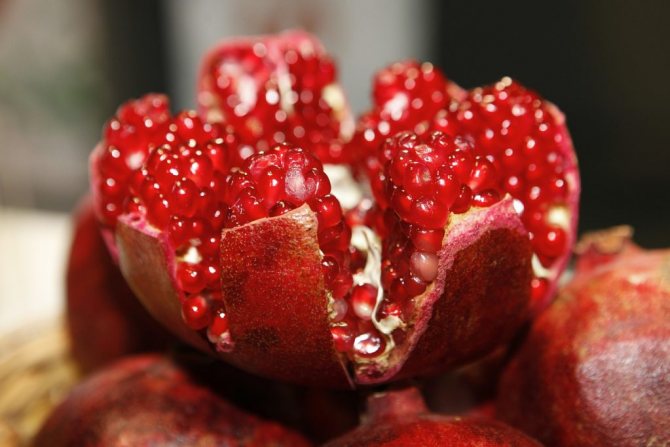

Pomegranate is a storehouse of vitamins
Due to the presence in the pomegranate of all these useful substances necessary for the human body, it determines its healing qualities. It is recommended for use to improve blood formation, quench thirst, to activate the production of hemoglobin, and the formation of red blood cells in the blood.
And also to strengthen the walls of blood vessels, the nervous system and raise immunity.
Even in ancient times, pomegranate infusion was used as an effective hemostatic agent.
Elderly people are also prescribed pomegranate to recuperate in the postoperative period. The pomegranate grains contain vitamin K, which is necessary for normal metabolism in connective tissues and bones, and is also needed for the absorption of calcium.
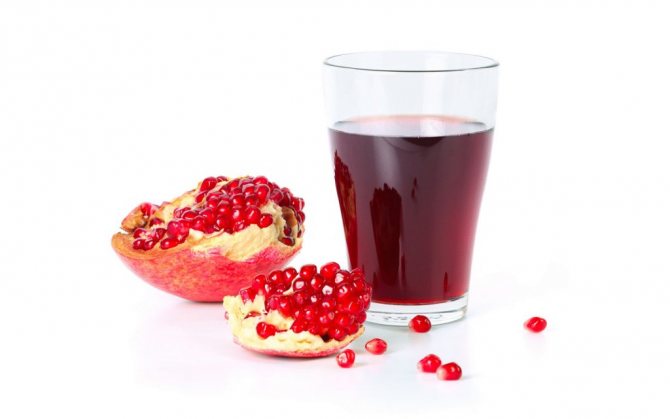

Drinking pomegranate juice can help normalize blood pressure
It is recommended as a hematopoietic agent for diseases of the cardiovascular system, circulatory system, respiratory system, kidney, liver.
Women during menopause can also include pomegranate in their diet to relieve symptoms, since it contains estrogens. Tropical fruit helps well in depressive conditions.
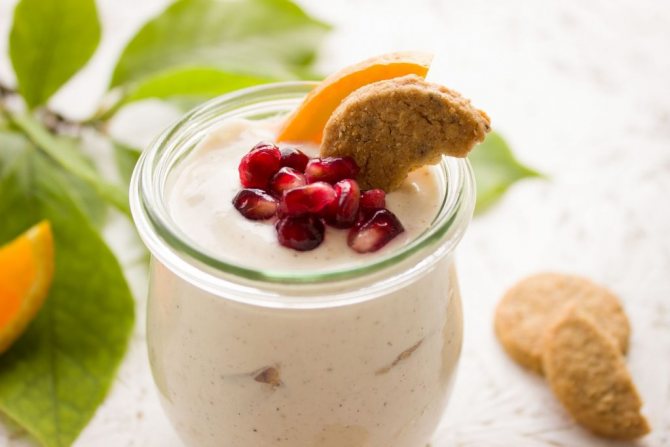

Pomegranate is quite popular in vegetarian cuisine.
Considering in the composition of its juice 15 amino acids, most of which are found in meat. It turns out that for people who have completely abandoned meat products, this exotic fruit can fully compensate for the lack of protein.
Another useful quality of pomegranate juice is the presence of a diuretic and choleretic effect, as well as anesthetic and anti-inflammatory effects.
The use of pomegranate has been observed to help with scurvy, uric acid diathesis, atherosclerosis, headaches and gastrointestinal disorders. For people who have undergone radiation, living in an area of high radiation and whose work is associated with radioactive isotopes, it is definitely recommended to consume this fruit.
Patients suffering from anemia, hypertension, bronchial asthma, malaria and diabetes mellitus are also prescribed pomegranate.
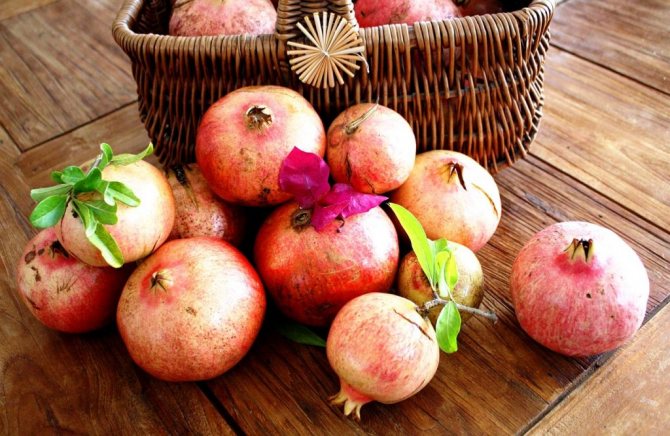

Due to the content of alkaloids in the pomegranate peel, the fruit has a strong antihelminthic property
For inflammatory processes in the liver, kidneys, joints, eyes, it is good to use a decoction based on pomegranate peel... Especially, it is good to use it for sore throats, problems with the gastrointestinal tract.
It is known to use pomegranate peel powder slightly fried in olive or butter for cosmetic purposes, as a remedy for oily skin of the face, for the treatment of various injuries of the skin.
The use of pomegranate seeds is quite actively used to improve the work of the intestines, in addition, they are a source of useful pomegranate oil, in which there is a high concentration of fat-soluble vitamins E, F.
They are necessary for rapid healing of wounds, restoration of epidermal cells, for rejuvenation and protection of the body from the development of cancer. With the help of pomegranate extract, you can restore the skin from sunburn.
back to menu ↑
See also: Homemade medlar: how to grow the favorite fruit of the Japanese from a bone on a windowsill (45 Photos & Video) + Reviews
Contraindications regarding the use of pomegranate
It is not advisable for people suffering from gastritis with high acidity, gastric ulcer and duodenal ulcer to consume pomegranate juice saturated with acids. If there is a need for its use, then it must be diluted with water.
In addition, pure pomegranate juice can corrode tooth enamel, therefore, immediately after drinking it, it is recommended to brush your teeth and rinse your mouth well with water.
If a person has intestinal problems, constipation, then the fixing property of an exotic fruit can exacerbate this problem. In case of an overdose of decoction from the peel, malaise, dizziness, convulsions may occur, and blood pressure will greatly increase.
In order to prevent a deterioration in general well-being, it is recommended to consult a doctor before using pomegranate decoctions.
back to menu ↑
See also: Sea buckthorn: description, cultivation, useful properties and contraindications, treatment, preparations for the winter - a symphony of benefits and taste! + Reviews
VIDEO: HOW TO GROW POMEGRANATE ON THE WINDOW
See also: Daylilies: description, classification of varieties, cultivation, care and reproduction + Reviews
The beginning of flowering and fruiting and features of care during this period
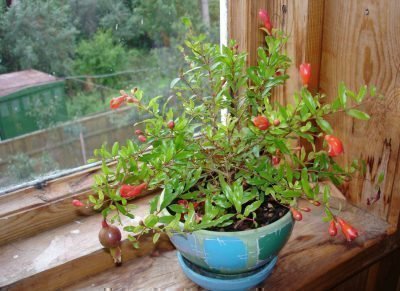

When breeding at home, you can often observe how the flower sheds its leaves at the end of November. This occurs after the ripening of its fruits. It is for this reason that many gardeners believe that then there is a dormant period when the plant needs to be kept in cooler conditions.
As a rule, young plants that have not reached the age of three years do not need special air cooling, they do not need rest.
When kept in a city apartment, you can, if you wish, lower the temperature of the plant by moving it a little closer to the glass and fencing it off with polyethylene. You can keep the flower in this way for three to four weeks. For the same period, a room pomegranate can be rearranged into the basement.
And in the end, we recommend watching the video material on the indoor grenade, we wish you a pleasant viewing.
Growing an indoor pomegranate is not particularly difficult. Subject to the basic rules of care, this delightful exotic plant will delight the eye with bright colors and even fruits.
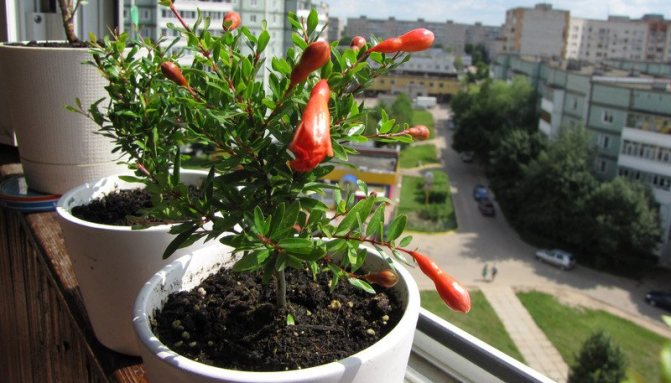

If any form of garden pomegranate grows as a room in a tub, then the tree will hibernate for the winter. In the fall, it will shed its leaves, and by the spring it will begin to release new ones. The dormant period lasts more often from November to February.
Planting / growing
Under the conditions of the room, the pomegranate tree is cultivated in several stages:
- growing season;
- winter rest time;
- awakening;
- resumption of flowering and distillation.
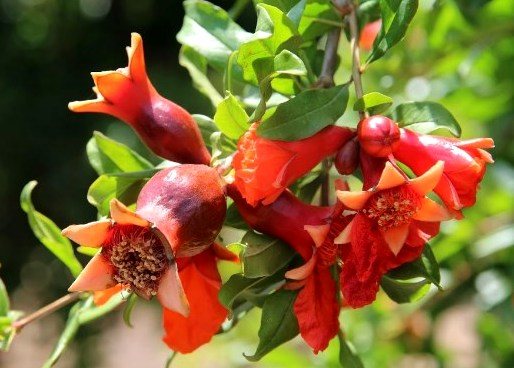

The most problematic in keeping a subtropical inhabitant in a city apartment with central heating in winter and low air humidity will be compliance with the natural development cycle. If at each of the stages due attention is paid to the plant, then its vital needs can be satisfied in central Russia.
Until the moment you purchase a pomegranate seedling in a store or nursery, take a responsible approach to the choice of purchase. Meticulously inspect both the aboveground part and the one that is hidden in the container. The leaves should be glossy and bright green in color. Carefully removing the bush together with the earthen clod from the container, assess the health of the root system. It should be well developed and have healthy white roots. Experienced flower growers recommend not throwing away the label with the name and a schematic description of the care requirements. This can help you navigate the rules for keeping this particular plant and prevent mistakes.
One of a number of arguments in favor of choosing an exotic plant is the mild requirements for the composition of the soil for indoor pomegranate. Any ready-made potting mix available from flower shops will do. But among the entire assortment, the most favorable for pomegranate will be a loose substrate with a neutral PH7 reaction, which has high air and moisture permeability properties. Pomegranate grows well in special soil for begonias or roses.


If it is not possible to purchase a ready-made substrate, it is prepared independently according to this recipe:
- humus (compost) - 1 part;
- garden land - 2 parts;
- sawdust - ½ part;
- river sand - ½ part;
- horse peat - ½ part.
As a flower pot, it is preferable to choose a sufficiently wide and deep container with drainage holes and a tray. To prevent stagnation of moisture at the root system, a drainage layer of expanded clay or other material suitable for its properties must be formed.

